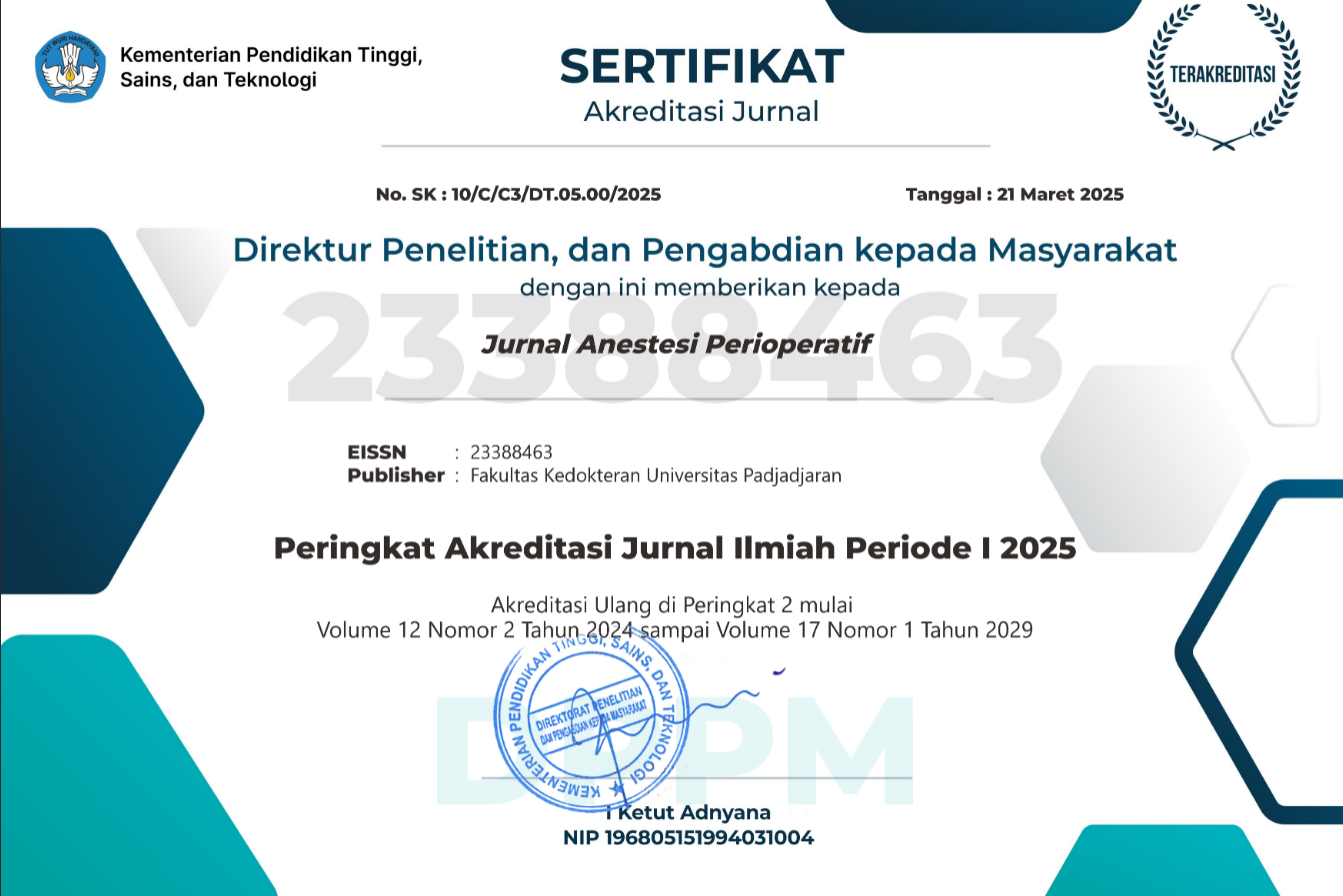Kesesuaian Pengkajian Nyeri Pascaoperasi dan Tidak Lanjutnya dengan Standar Prosedur Operasional Asesmen Nyeri pada Pasien Pediatrik di RSUP Dr. Hasan Sadikin Bandung Tahun 2016
Abstract
Nyeri bukan hanya persepsi sensorik, tetapi juga emosi, kognitif, dan perubahan perilaku Pengkajian nyeri pada anak dinilai dengan berbagai sistem skoring. Rumah Sakit Umum Pusat Dr. Hasan Sadikin Bandung telah membuat Standar Prosedur Operasional untuk menilai nyeri di ruang perawatan. Penelitian bertujuan mengetahui kesesuaian pengkajian nyeri pascaoperasi dan tindak lanjutnya dengan SPO asesmen nyeri pada pasien pediatrik di Rumah Sakit Umum Pusat Dr. Hasan Sadikin Bandung pada tahun 2016. Penelitian menggunakan metode deskriptif observasional retrospektif terhadap 158 rekam medis pasien pediatrik yang dirawat pada tahun 2016. Penelitian dilakukan di RSUP Dr. Hasan Sadikin sejak Februari sampai dengan Maret 2018. Hasil penelitian mengungkapkan bahwa pengkajian nyeri sesuai SPO adalah 150 pasien (94,9%), tidak sesuai SPO 8 pasien (5,1%). Tindak lanjut pengkajian nyeri yang sesuai SPO adalah 138 pasien (87,4%), tidak sesuai SPO 13 pasien (8,2%), dan tidak dilakukan tindak lanjut 7 pasien (4,4%). Evaluasi ulang setelah tindak lanjut pengkajian nyeri sesuai SPO adalah 130 pasien (82%) dan tidak sesuai SPO 28 pasien (18%). Simpulan penelitian ini bahwa pengkajian nyeri pascaoperasi dan tindak lanjutnya sebagian besar sudah sesuai dengan Standar Prosedur Operasional.
Kata kunci: Nyeri pascaoperasi, pediatrik, pengkajian nyeri
Compliance of Postoperative Pain and Follow Up Assessment with Painful Assessment Standard Operating Procedures in Pediatric Patientsin Dr. Hasan Sadikin Bandung Year 2016
Pain does not only involve sensoric perception. It also involves emotional, cognitive, and behavioral changes. Pain assessment inf children is performed using various scoring systems. Dr. Hasan Sadikin General Hospital Bandung has developed Standard Operating Procedures to assess pain in treatment rooms. The objective of this study was to determine the compliance of postoperative pain assessment and its follow-up to the SOP on pediatric pain assessment in Dr. Hasan Sadikin General Hospital Bandung in 2016. This was a retrospective observational descriptive study on 158 medical records of pediatric patients who were treated during the period of 2016. The study was conducted from February to March 2018. It was revealed that pain assessment was assessed in compliance to the SOP in 150 patients (94.9%) while the remaining 8 patients (5.1%) were not assessed according to the SOP. The follow-up of pain assessment was performed in compliance with the SOP in 138 patients (87.4%), Thirteen patients (8.2%) were followed up using procedures that are not in compliance with the SOP while 7 patients (4.4%) were not followed up at all. Reevaluation after pain assessment follow up was performed in compliance with the SOP in 130 patients (82%) while the remaining 28 patients (18%) were reevaluated without using the SOP. It is concluded that most postoperative pain assessments and their follow-up are conducted in compliance with the Standard Operating Procedures.
Key words: Postoperative pain, pediatric, pain assessment
Keywords
Full Text:
PDFReferences
Wong C, Lau E, Palozzi L, Campbell F. Pain management in children: Part 1 — pain assessment tools and a brief review of nonpharmacological and pharmacological treatment options. Can Pharm J. 2012;145(5):222–7.
Brasher C, Gafsous B, Dugue S, Thiollier A, Kinderf J, Nivoche Y, dkk. Postoperative pain management in children and infants: an update. Pediatr Drugs. 2014;16:129–40.
Nair S, Neil MJE. Paediatric pain: Physiology, assessment and pharmacology. ATOTW. 2013;289:1–10.
Cohen LL, Lemanek K, Blount RL, Dahlquist LM, Lim CS, Palermo TM, dkk. Evidence-based assessment of pediatric pain. J Pediatr Psychol. 2008;33(9):939–55.
Thienthong S, Sriraj W, Siripul P, Finley A, Boonyawattanangkool K, Kasetwetin S. A survey of postoperative pediatric pain management among seven hospitals in northeastern Thailand. Anaesth pain & intensive care. 2014;18(1):59–71.
Sadikin RDH. Asesmen Nyeri. Bandung: RSUP Dr. Hasan Sadikin; 2015. hlm 1–3.
Moura LAd, Oliveira ACDAd, Gilberto de Araujo Pereira, LV P. Postoperative pain in children: a gender approach. Rev Esc Enferm USP. 2011;45(1):831–6.
Kozlowski LJ, Kost-Byerly S, Colantuoni E, Thompson CB, Vasquenza KJ, Rothman SK, dkk. Pain prevalence, intensity, assessment and management in a hospitalized pediatric population. Pain Management Nursing. 2014;15(1):22–35.
Kinjo S, Sands LP, Lim E, Paul S, Leung JM. Prediction of postoperative pain using path analysis in older patients. J Anesth. 2012 26(1):1–8.
Donya Panjganj, Bevan’s A. Children’s nurses’ post-operative pain assessment practices. Nursing people and young children. 2016;28(5):29–33.
DOI: https://doi.org/10.15851/jap.v6n3.1347
Article Metrics
Abstract view : 1226 timesPDF - 446 times
This Journal indexed by

JAP is licensed under a Creative Commons Attribution-NonCommercial 4.0 International License
View My Stats



